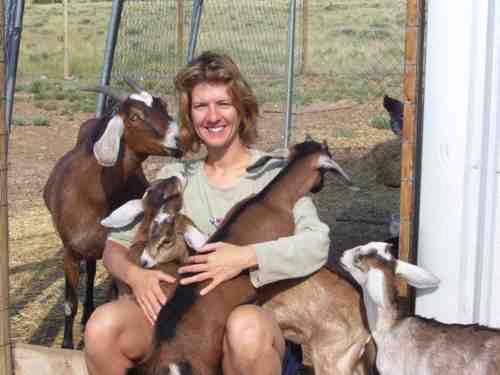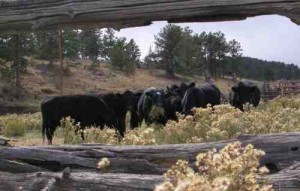Article by Patty Lataille
Agriculture – January 2008 – Colorado Central Magazine
CARING FOR FARM ANIMALS in today’s ultra high tech and modernized age can be a refreshingly innocent and unpretentious pastime. Raising baby goats can actually help reduce your profound cynicism of the world’s current state of affairs down to manageable levels.
I now know where the expression “Jumping for Joy” originated. I’ve been the mountain for numerous “King of the Mountain” games with three nanny goats competing to climb on top of my head and shoulders. Not many newborns are as cute and friendly as little kid goats, racing around within hours of their birth. Rubbing their little nubbins — tiny horns beginning to sprout on the heads of month-old kid goats — is similar to petting a dog; those tiny goats like to nuzzle in so sweetly.
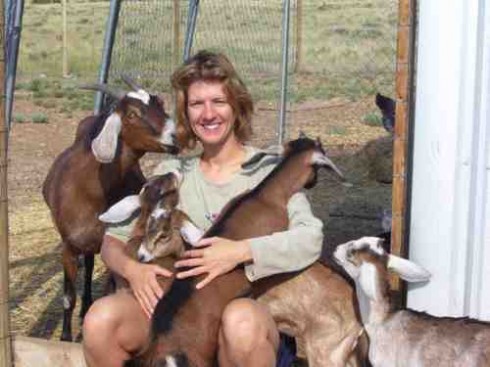
These baby goat scenarios were completely outside of my realm of knowledge and experience until recently. Having been born and raised on Long Island, close to Queens (a New York City borough), I might have seen a goat once — on a visit to the Catskill Game Farm. I remember being slightly terrified of all the tame “wildlife,” and sure enough, there exists aging photos of my brother, sister and me crying our eyes out on that family vacation.
Strange to think that I now live on a mini-farm — 121 acres of flat prairie land with stunning views of the Sangre de Cristo mountain range — in the San Luis Valley of Colorado. My husband Jack, a native of the state, grew up in a ranching family near Trinidad. Life didn’t seem complete to him without acreage, a flock of chickens, a couple of geese and dairy goats to milk and make cheese from.
I was one of those “city girls” who always wanted to live on a farm. I had the romantic dreams of living in an old farmhouse surrounded by bucolic beauty, with cows and goats and lots of chickens — and of course, gentle steeds for me and my farmer/cowboy sweetie to ride off into the sunset with. As a vegetarian and animal lover, I had looked forward to pastoral peace, hay rides, sweet tempered and well-cared for livestock and a pig named Wilbur. No animal would die on my farm unless it was due to natural causes.
Along came the reality check. Factor in the cost and expense of feed along with your time investment, and gentle horses that respond to my whistle are still a dream away. Our first goats were Lido and Patch who were purchased from neighbors up the road. Jack surprised me with the gift and I accompanied him to choose my goats. Lido the white La Mancha turned out to be unafraid of anyone or anything, and was aggressively friendly to humans, and literally a “butthead” to all other barnyard inhabitants. Timid Patch, the burnished brown Nubian with big white floppy ears, became Mama to three hungry nanny goats — Scout, Sally and the runt Bambi.
Lido lost her babies two months shy of her due date, so Patch had been our only hope for kids and the accompanying milk to make goat cheese. Since I had never even heard of the 4H program before moving to Colorado as an adult, the entire subject of goat breeding, pregnancy and birth was a source of wonder and mystery to me. Bringing in Bandit — the stud Billy goat — was interesting. Not only did we have to feed his big appetite and smell his stink for a month, but he got to chase our girl goats around all day, looking for the right opportunity to mate. I considered this to be high times at Camp Goat Go Have Sex, and I was shocked to find out that we actually had to pay for this privilege.
I WAS IMPATIENT, waiting for Patch’s pregnancy to end. Dutifully we fed her alfalfa pellets, beat pulp, alfalfa hay, table scraps and bread (she likes bagels most of all). We would take her and Lido for daily walks on our property for them to munch on their cottonwood (goat candy) leaves. Feeding them was expensive and time consuming and Jack threatened that they would have to go away if they didn’t “produce” .
Producing pets? That was a concept I was unfamiliar with. I’d always shared my life with companion cats and dogs and various pet rodents and a fish or two, but never with animals that were under any pressure to “produce.” Patch did extremely well for a yearling, giving us three nanny goats and producing almost a gallon of milk daily. I had argued for Lido to stay despite her shortcomings.
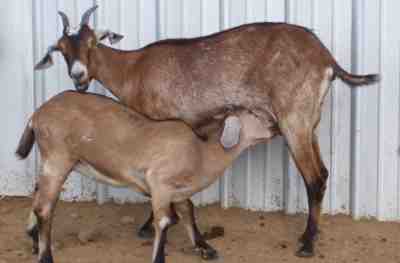
When Spring finally arrived, it came with warm temperatures, green grass growing, more eggs to hunt for, daily swims for the geese in their kiddie pool — and baby goats!
I missed the main miracle — the actual birth — while fidgeting in a community meeting during my workday. Jack notified me by phone that the babies were here — two fine and healthy and the little “pinko” (runt) that might not make it. He asked me to pick up bottles and nipples so that we could bottle feed her. Off I raced to the store, wildly excited that Patch’s pregnancy had finally come to an end and I could now experience the little kids.
“Bambi” (the runt) arrived as a damp pile, left in a forlorn heap in the corral with the rain and sleet pelting her tiny newborn self. Patch was too busy to care for her as she continued to birth the remaining triplets that were now arriving in a warm barn with Jack’s assistance. As he left the barn, he heard a faint noise over the storm and searched for the source of the tiny bleats, finding the runt hypothermic and barely hanging on to life.
Jack carefully picked up the tiny two pound “pinko” and cradled her under his sweatshirt to keep her warm. Later he wrapped her in a towel and placed her on the dog bed in the back of our green Subaru Forester.
By the time I arrived home, Patch was exhausted but eating, Sally and Scout were wobbling around on their newfound legs and the little runt was still alive, so fragile and making little mewing kitten noises. We took her home and placed her in a cardboard box in the warm kitchen. Getting her to drink from a bottle when she could barely stand upright was a challenge. Her hooves were clear gelatinous lumps at the end of her spindly legs — legs that played out and sent her sprawling, reminiscent of Bambi on the ice pond with Thumper.
I marveled at her delicate mocha brown-colored form and petite little features. She was tiny and frail as I cradled her in my lap, determined that she was going to live. Overnight her hooves hardened and turned black. She tried her best to stand without swaying.
Her sisters were strong and sturdy and appeared to be thriving in comparison to Bambi’s puniness. Patch ignored Bambi after the second day, no longer recognizing her smell, and we fed the baby when we milked Patch, helping her stand and brace herself to latch onto her mama’s teat. She was still too weak to butt her head or “punch” Patch’s bag to bring the milk down, but we made sure she drank her fill and tottered away with a huge pot belly full of rich mama’s milk.
Too delicate to leave with aggressive Lido and her rambunctious sisters, Bambi joined our household in a human/dog/baby goat capacity. Bottle fed and cuddled similar to a human child, she soon slept in her box amidst the dog beds and spent her days in the yard with Maya, the black and white border-collie lab mix, and Kharma, the jealous four-month-old tan dachshund and Mexican beach dog puppy mix. None too pleased with the attention being showered on Bambi that had most recently been hers, Kharma spent her days trying to terrorize our mini-goat.
HAVING BEEN SEVERELY reprimanded to leave Bambi alone, along with the ubiquitous command to “Be Nice” , Kharma harassed the baby goat on the sly. I responded to many bleats of distress, most of which seemed to come from the shallow window well where Bambi always seemed to end up. After scooping out the baby goat to put back into the yard, I wondered why Bambi kept falling in there when she knew there was no way to get out.
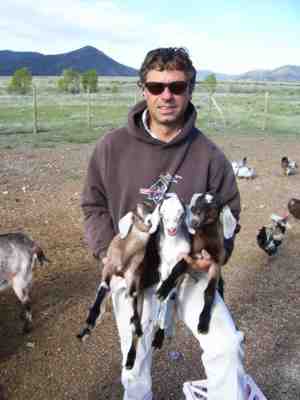
After observing Kharma’s antics one day, I realized that the puppy actually herded the baby goat to the edge of the window well and then nonchalantly “hipchecked” her in. Bambi would cry, I would pick her out of the well and then Kharma’s harassment tactics (including racing alongside and biting on her legs as well as jumping on top to dominate) would begin again. After awhile, Bambi began jumping in the window well on her own to avoid contact with Kharma. Smart goat.
Bambi was better house-trained than the puppy for the first couple of weeks. She would be taken outside at night for a final pee and then placed in her box until the next morning. She learned to hold it through the night and would take care of her business outside in the morning.
Then Bambi got bigger and Kharma mellowed out. They all rode together in the back of the Subaru going on trips as far away as Ludlow (2.5 hours away.) Bambi visited the Big R Feed Store in Alamosa, where she was petted and even kissed by customers and employees. She became a very social goat, racing up to see us and hanging close to her human herd during house construction.
IF LAP SPACE WAS AVAILABLE, Bambi was in it. She competed with Kharma to see who could get in my lap first and stubbornly kept her place, even with Kharma lying on her head. Jack warned me that while it may be cute now, it would cease to be so amusing when the goat weighs 100 pounds.
The deal was that she could keep coming home with us at night as long as she fit in her box. At one month old, Bambi could still fit, but she wouldn’t stay in her box. One night she cleared the four foot doggie gate and wound up in our bedroom. Jack marveled at her athleticism as she was only 18 inches tall at the time. But that was her last night here at her human home. Then she overnighted in the barn with the other goats, but still spent the days with Jack, entertaining him as he worked by demonstrating her “Matrix moves” off the walls and by spontaneously leaping sideways for joy.
One afternoon I was gathering eggs and watching the babies run, jump and play after our daily goat and dog walk. Out of the corral, away from big mean Lido, they were constantly butting heads and rearing up in a playful manner. I placed the basket of eggs carefully on top of the Subaru, meaning to put them away as soon as I finished the chores. A few minutes later, Jack stepped into the barn and asked me if I had left the egg basket on top of the car. When I nodded, he sighed and held the door open, inviting me to come view the devastation.
HAVE I MENTIONED that goats like to climb? Especially little curious baby goats who find climbing on cars and leaving scratches and hoof prints on the hood especially entertaining. With remnants of eggs dripping from the roof and green exterior of the Subaru, little Sally was now bucking and kicking and racing down the driveway, with the basket firmly affixed to her head and shoulders.
Not having realized that those silly goats would immediately hop on the car to investigate the basket, I laughed at my naiveté and at the baby goat still trying to free herself from the wicked wicker. Now that was a lesson learned — and all goats were kept inside the corral when cars parked in the driveway from that point on.
When Patch became “knocked up” again, she was pretty feisty and always ravenous. One morning, I had opened the barn door to let the “hungry hordes” out and she appeared with a feed bucket slung around her neck. It took a while to corner her and yank it off — she was a bit freaked out by that scary thing attached to her.
BAMBI’S WINTER COAT GREW IN. She was a fuzzy little one and still cute and small enough to ride in the back of the Subaru with the dogs. Bambi had figured out how to help me round up the chickens at night. With her bucking and leaping and racing around, she managed to run the chickens inside the barn. She continued to play hard while accomplishing the objective.
Along with Patch’s girth and appetite increase, we noticed a size increase in little Bambi overall. She metamorphosed into a real (albeit still small) goat, seemingly overnight. When Jack noticed her little bag getting fuller and her midsection expanding, we realized that Bandit had accomplished his mission only too well. Now we had two preggo goats, with one being a high-risk situation. We watched Bambi carefully — there was no way this tiny goat could have a number of kids safely.
Patch gave birth to three little nannies, whose coloring prompted their naming: Mocha, Latte & Cappuccino. The babies were healthy enough, although two seemed a bit premature and their hooves & ankles were too weak for them to stand properly. When I came home to this latest miracle, I immediately scooped them up and asked Jack to please do something, especially for the sweet white Latte, who could barely stand. Although Jack was of the mind-set that some kids just shouldn’t make it — natural selection and all that — he agreed to make splints for their crippled legs.
Out came the duct tape and stiff cardboard from toilet paper rolls. While I held the wiggling, squealing kids, with Latte giving true meaning to the expression “The squeaky wheel gets the grease,” Jack wrapped up their tiny legs to give them the support to stand. As they hobbled off, Jack shook his head at the loudly bleating Latte. “That one was coyote bait for sure,” he said quietly. Patch seemed to agree as she took Mocha & Cappuccino to nurse and warded off little Latte. We had to put Patch’s head in a stanchion so the little runt could nurse.
Two days later the casts were off and the babies cavorted freely around the corral. It appeared that they were all going to make it just fine, with a little extra TLC for Latte. She took to being a lap goat in no time. With a soft white coat and long eyelashes, she was like a little fawn and loved to be cuddled. When it was “Lap time” after chores, Mocha & Cappuccino loved to jump right in as well. Luckily Bambi was merely curious and not aggressive to the kids.
While we enjoyed the baby goat games, we continued to watch Bambi carefully, anxiously awaiting the big day. My close girlfriends — the Goddess Girls — stopped by on their way to Joyful Journey Hot Springs to pick me up and spent a few minutes admiring our new barnyard critters. As we stood in the corral petting baby goats, Danielle looked at Bambi and commented, “It’s show time!” Bambi was leaning against the fence, panting and straining. My first reaction was denial, because Jack was out on a long hike with the dogs and what did I know about birthing baby goats?! But I knew it was time, and as I watched, Bambi’s yellow-tinted amniotic fluid sac popped out and splashed as it hit the ground. With none of us having given birth, we still knew enough about the process to realize that the water had broken and birthing had begun. But something seemed wrong. Bambi was in distress and no little creature seemed to be coming out.
As the girls gathered around Bambi, now lying on the ground and straining mightily, we looked at each other with anxious expressions and out came the cell phones to call Jack. He answered and I excitedly told him that Bambi was giving birth but it seemed to be a crisis situation. He was twenty-five minutes away and I knew that Bambi could wear herself out and the baby die if something wasn’t done sooner.
Shannon no sooner said “She looks like she needs help,” and there I was pulling off my hoodie and lying down behind Bambi, trying to see a sign of the baby. There was a teeny hoof poking out and I tried to grab it, hoping mightily that the kid was turned face forward and not breech. After managing to catch hold of two slick hooves, I tugged gently and a little snout appeared. So far, so good — as I kept guiding the little baby goat out of the birth canal with blood, fluid and the embryonic cord trailing out on top of me. As the complete baby goat finally made her appearance, a collective “Awwww…” came from the girls as digital cameras kept flashing and we all shared in the miracle of birth.
ONCE THE NANNY WAS OUT and amazingly already trying to stand, I laid her next to her mama’s head, hoping Bambi would accept her. Then we stood there watching uncertainly until Jack appeared and grabbed my sweatshirt to rub her down and warm her up. Then Bambi started to sniff her baby and lick her clean. A sense of relief flooded through the group and I had an inspiration. “She’s the Goddess Goat,” I announced with joy. Murmurs of agreement marked the moment.
Jack gave me a sideways smile and said “Your first birthing experience — you did well. Not bad for a city girl.” Proud of my accomplishment, I spent the next few days announcing to friends and family that I was now a goat Doula and I watched with pride as the Goddess Goat grew into our sturdiest kid of show quality.
Bambi became a conscientious mama goat and took good care of Goddess, in addition to providing plenty of milk for all of us. It was comforting to see them together — Bambi finally had a friend in the barnyard. Not much older that the kid herself, Bambi would play and cavort with Goddess, even as Goddess grew at a rate that would soon surpass Bambi’s diminutive size.
NEARLY THREE MONTHS PASSED before we came home to drama, and then trauma, with Goddess Goat. That beautiful strong healthy creature had blood dripping down her left leg from a deep gash just above her knee. She favored the leg, barely putting any weight on it — it looked nasty. Jack took one look and said that she had severed her tendon and that was basically it for her. I insisted that he hold her still while I washed off her leg with antiseptic to see how serious the wound was. It was deep, but healing, and just seeing how her leg swung almost uselessly, I knew this was bad. Within a few days, I noticed that the wound had healed, but Goddess was still limping badly and Jack did not seem optimistic. Fortunately, a few weeks later we had the animals out for a walk — six leaping jumping silly goats — and Jack remarked that Goddess goat would never be healed, but she was learning to live with her disability. One could barely notice her affected gait.
During winter preparation and maintenance in the barn/shed, we found out too late that there was a hole in the fence big enough for a goat to squeeze through, especially a little runt goat who’s specialty was breaking and entering. I found Bambi gorging herself literally to death after removing all four feed bin lids and helping herself to flaked corn, chicken scratch, alfalfa pellets and sweet mix. Not having the knowledge of the ramifications to this act, I chased her outside and admonished her as a “Bad goat.” I informed Jack when he came home and he looked concerned, saying that if she makes it through the night, she would probably live. I looked at him in horror. “What do you mean, If?” I questioned. “How do you die from eating too much?” Sure — bloating — an upset stomach — that all made sense. Where did the specter of death enter this scenario?
Jack explained that goats have four stomachs and if they eat too much rich grain or feed, the digestion slows down and the natural enzymes are overcome by the growth of bacteria that are common in their stomachs but go haywire in this case. The condition is known as Enterotoxemia and is often fatal.
The next day Bambi was still with us, but obviously very ill and in major discomfort. Her baby Goddess stayed close and I watched them together. Bambi didn’t join us for our nightly walk. I patted her and her baby and brought them inside the barn for the night.
The next day I entered the barn and saw Bambi’s head and neck at an unnatural angle and knew immediately that my favorite goat had died during the night. Goddess, however, didn’t realize that her Mama was gone. She bleated and cried the whole day, confused and wandering around searching for her. The other goats shunned her presence, except Latte who on occasion seemed almost grateful that now there was another pariah to take her place.
This was almost too much to bear. To lose my precious Bambi goat and have a little crippled orphan nanny to take care of was breaking my heart. Then to find out that there does exist a vaccine to administer directly after an overeating incident which could prevent the bacterial overgrowth was a final kick in the heart.
While I realize that these losses are a part of life — and for animal lovers such as me — one of the more difficult life lessons that we learn at some level — my overriding reaction was “I am not cut out for this.”
To have formed such a strong attachment with a barnyard animal — not technically a pet — but not the usual livestock creature either — was a risk. Every relationship — every human-animal bond — becomes a leap of faith. Thankfully many human and animal friendships turn out to be longer in length and intensity. Bambi lived with us for 18 months and her death — while not a tragedy to many — is a significant loss in my life.
Patty LaTaille is spending her first winter in the papercrete house she and her husband, Jack, built in the Villa Grove area. This is an excerpt from her book in progress, Little House on the Modern Prairie.

